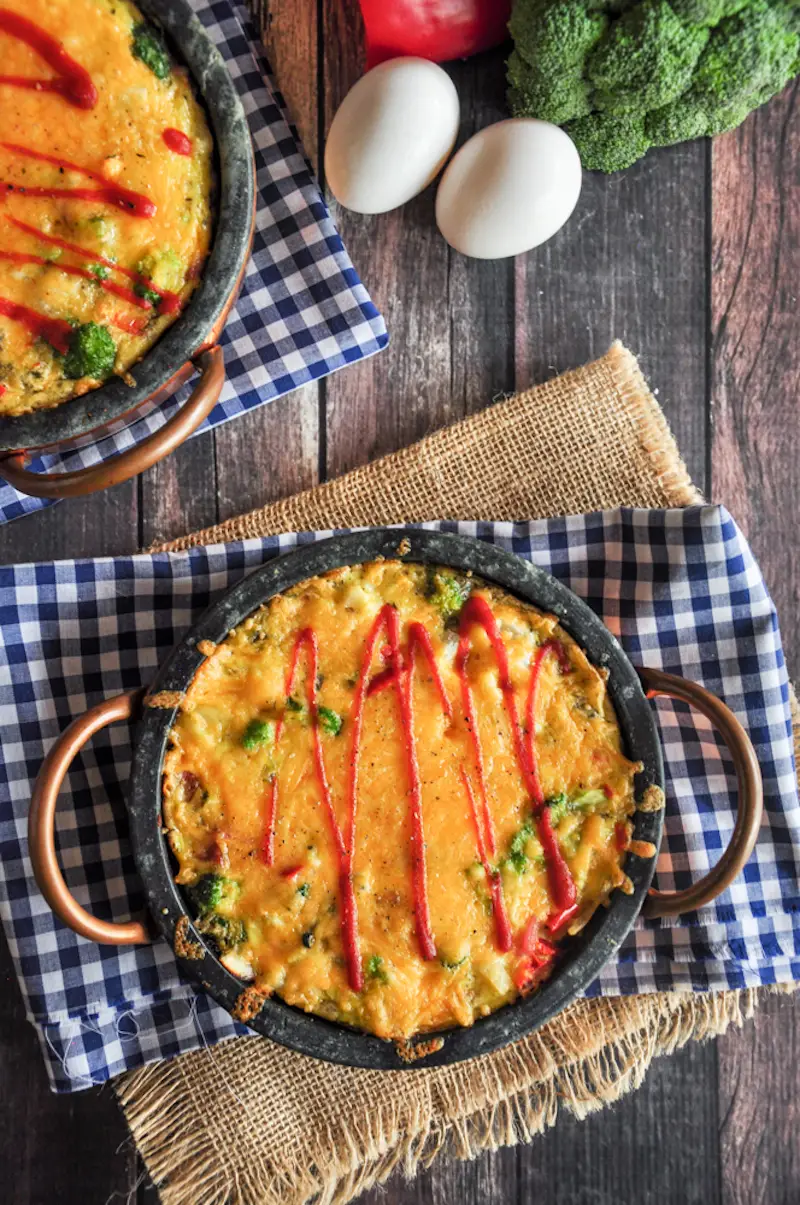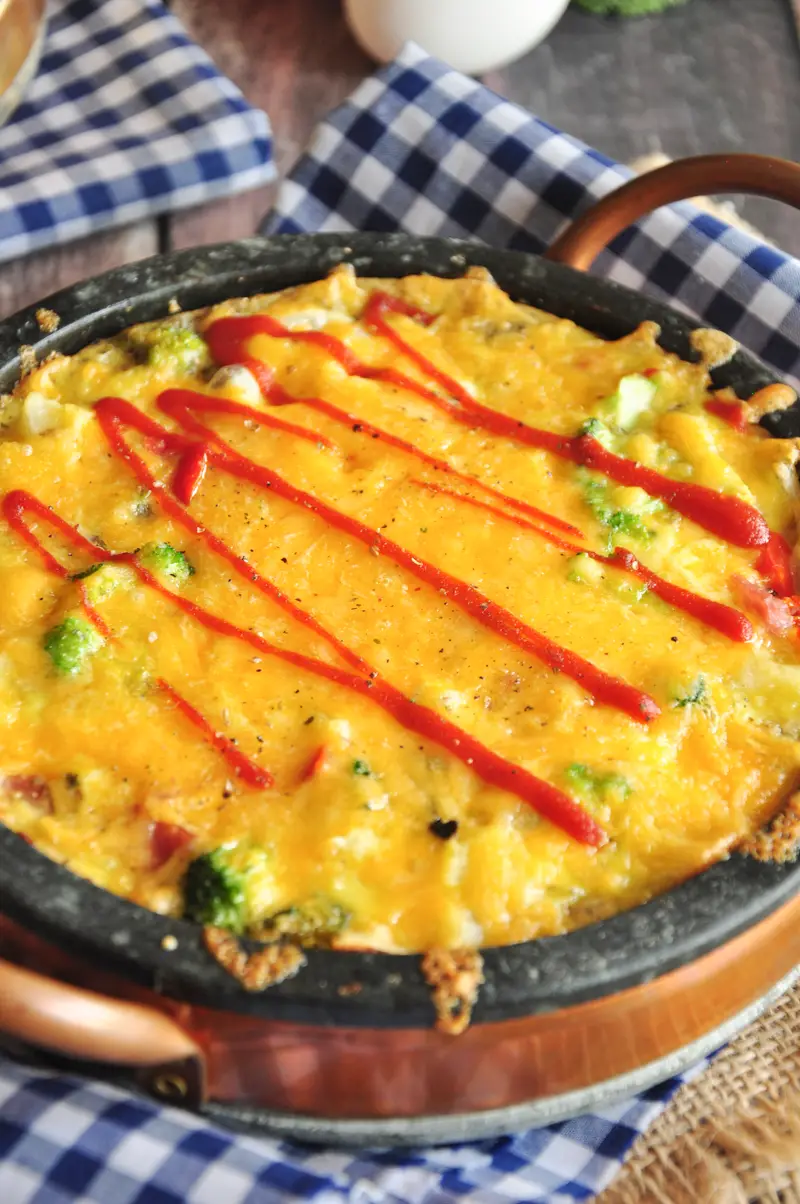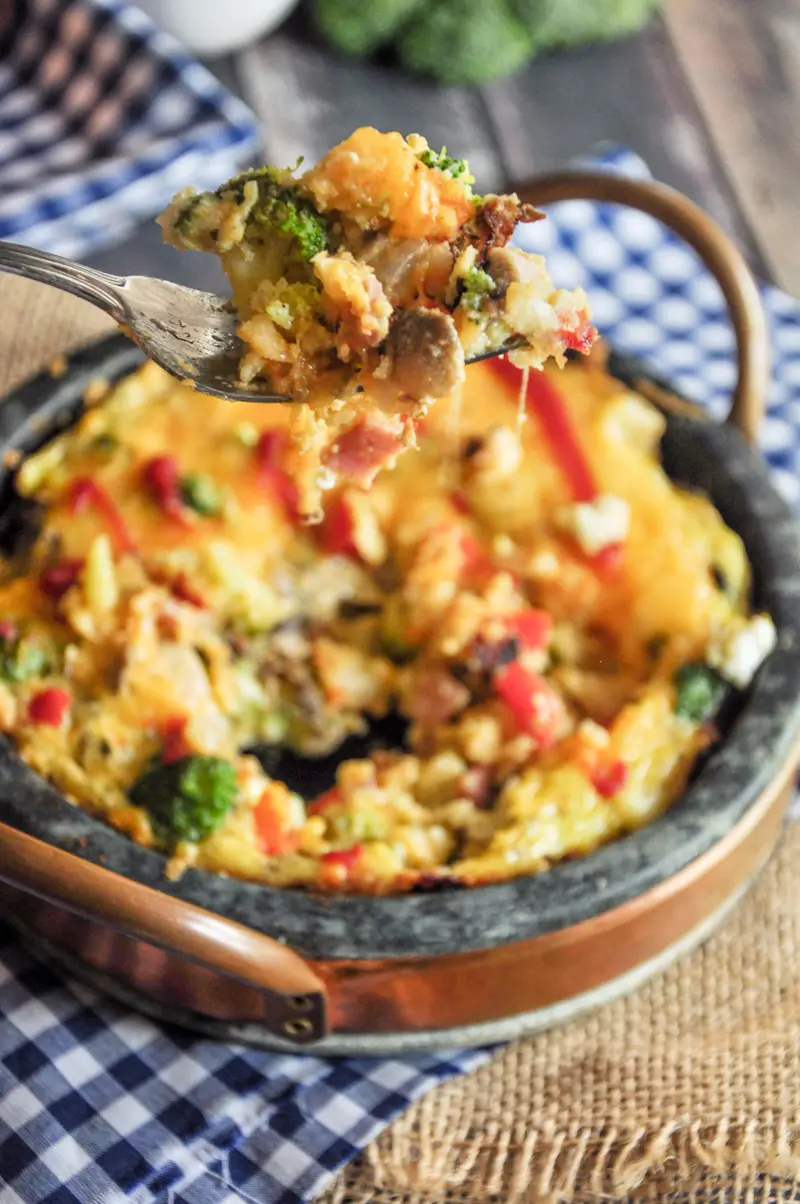Oven-to-Table Baked Frittata Recipe
Upgrade your next brunch with this baked frittata recipe. It’s filling, ready in 30, and easy to customize based on the ingredients you already have.
Oh, baked frittata, I love thee a-lotta.
If you’re growing tired of bacon, toast, and over-easy eggs every weekend, here’s an idea for your next home-cooked brunch. Not only is this baked frittata recipe easy to make, but it’s also filling, delicious, and ready in 30 minutes or less. Plus, you can customize the ingredients and use up any produce you already have in the fridge.
Frittatas are also known to pair fabulously with a mimosa or two. Who’s bringing the champagne?
Before we get started, I want to share a little Frittata History 101 with you.
- Do you know what the word “frittata” meant in Italy?
- What’s the Difference Between an Omelette and a Frittata?
- How to Make a Frittata (Step by Step)
- 4 Ways You Can Customize This Baked Frittata Recipe
- Why I Prefer Cooking with Soapstone Over Cast Iron (Especially When Making a Frittata)
- Baked Frittata Recipe
- About the Author
Do you know what the word “frittata” meant in Italy?
The word frittata loosely translates to “fried” in Italian.
The Italian folk used the word frittata to describe eggs cooked in any fashion in a skillet rather than a particular dish. So, if you were in a café sipping a macchiato and decided to ask for a frittata, you could be ordering anything from fried eggs to omelettes or Spanish patatas.
However, outside of Italy (and especially in the American culture), frittatas were considered “Italy’s version of open-faced omelettes.” And that, my friends, is what we’re making today.

What’s the Difference Between an Omelette and a Frittata?
While a frittata looks like and has similar ingredients to an omelette—different types of meats, veggies, and melted cheese—the major difference is the cooking method.
Unlike an omelette, a frittata requires you to start by cooking your veggies, meat, and hashbrowns in a skillet or cast iron pan until tender, and then to pour the beaten egg mixture over top of the ingredients to cook until the bottom becomes slightly crispy. No flipping of any sort takes place.
As you may have noticed, with this particular baked frittata recipe, you can cook the hash browns right into the dish itself, which adds another element of flavor and texture. With an omelette, you’d always serve hash browns on the side. It’s a delicious change-up.
The frittata egg mixture is also seasoned with salt, pepper, and a pinch of dried tarragon. These seasonings run evenly through the frittata when you beat the eggs vigorously, which is an important step because it also incorporates more air into the egg mixture. This is what you want, because it yields a deeper filling and fluffier frittata. Heck yes.
On the other hand, an omelette will often use milk or heavy cream to achieve a fluffy texture.

How to Make a Frittata (Step by Step)
As I promised you, a frittata is very simple to make. However, there is one thing you can do to help the whole process go smoothly—and that would be to have a trusty cast iron skillet or a soapstone sautépan that can go directly from the stove into the oven to be baked.
As an added bonus, you can serve the frittata straight out of the same skillet to save on clean-up.
- Step One: Prepare your egg mixture and set aside. Cook veggies, meat, and hashbrowns in the skillet until tender.
- Step Two: Pour the runny egg mixture on top of the meat, veggies and hashbrowns and allow it to set on low heat for 8-10 minutes or until the bottom becomes slightly crispy. Since you’ll need a little bit of patience during this step, now is a good time to grab your coffee or mimosa and take a little break. Also, don’t forget to preheat the oven now if you haven’t already.
- Step Three: Once the egg mixture has set, it has not yet matured into a frittata! It still resembles an open-faced omelette. However, the final (and most exciting) step is what turns it into a frittata.
- Step Four: The final step is to sprinkle a thick layer of cheddar cheese on top and pop it in the oven to bake. Watch through the oven window in anticipation as the cheese creates a layer of delicious, gooey, bubbly heaven.
Once the cheese is evenly melted, and your open-faced omelette has been baking for seven minutes or so, you have officially made a frittata. Congratulations!
You could even go as far as calling it a crustless, gluten-free quiche. Whatever floats your boat. Now, slice it up, serve, and dive in.

4 Ways You Can Customize This Baked Frittata Recipe
Like omelettes, the beauty of this baked frittata recipe is that you can make a different version every time. In fact, a frittata is a perfect breakfast or brunch if you want to use up produce that’s about to go to waste.
- If you want to make a vegetarian frittata simply omit the meat and add extra veggies, like zucchini or asparagus.
- Greens like kale, swiss chard, spinach, and arugula add a pleasant hint of bitterness (and extra nutrients).
- Green onions or red onions also pair well with a frittata. Feel free to use either one in addition to the diced yellow onions in this recipe.
- Not a cheddar fan? You can use feta, goat cheese, and parmesan in addition to or in place of cheddar cheese.
Why I Prefer Cooking with Soapstone Over Cast Iron (Especially When Making a Frittata)
To be honest with you, I love my cast iron skillet to death, but I prefer my soapstone sautépan, especially when I’m making a frittata. Here’s why.
- It withstands temperatures up to 1800°F.
- Soapstone is a rock that lasts forever, as long as you give it proper care. (In other words, a soapstone pan is a good one-time investment for your kitchen that provides an endless return.)
- It heats up fast and evenly, which provides excellent baking results, and it keeps hot food hot for longer periods at room temperature.
- You can also pop soapstone in your freezer for an hour and use it to serve your frozen treats, like ice cream. It will keep your goods chilled longer at room temperature, even on a scorching summer day.
- As an added bonus, I love that soapstone cookware has a sleek, elegant design, which makes you feel like a queen (or king) when eating at home.

Baked Frittata Recipe
- Prep Time: 10 minutes
- Cook Time: 20 minutes
- Total Time: 30 minutes
- Yield: 2 servings 1x
- Category: Gluten Free
- Method: Stove & Oven
- Cuisine: Italian
Description
Upgrade your next brunch with this baked frittata recipe. It’s filling, ready in 30, and easy to customize based on the ingredients you already have.
Ingredients
- 2 tablespoons cup onion, diced
- 2 tablespoons cup red bell pepper, diced
- 1/2 cup broccoli, cut into small florets
- 1/4 cup mushroom, sliced
- 1/2 cup turkey ham, diced
- 1/2 cup frozen diced hash brown potatoes, thawed
- 3 large eggs, beaten
- 1/2 teaspoon sea salt
- 1/4 teaspoon ground black pepper
- 1/4 teaspoon dried tarragon
- 1 tablespoon butter or olive oil
- 1/4 cup shredded cheddar cheese
- Sriracha or ketchup (optional)
Instructions
- Preheat oven to 350°F.
- Chop onion, red bell pepper, broccoli, and mushroom, and set them aside all together. Dice turkey ham and set aside with hash brown potatoes.
- Whisk eggs with salt, pepper and tarragon in a large bowl and set aside.
- In a 6-inch soapstone sauté pan or cast iron skillet, melt butter over medium heat. Add onion, bell pepper, broccoli and mushroom; cook for 4-5 minutes or until the vegetables are tender.
- Add turkey ham and potatoes; cook for another 2 minutes, stirring often.
- Pour egg mixture into the pan; switch to low heat and let it cook for 8-10 minutes or until the egg is about to set and the bottom is slightly crispy.
- Remove from heat; sprinkle with cheddar cheese and bake for 5-7 minutes, uncovered.
- Drizzle with Sriracha and serve immediately.
Notes
- This recipe can be made in a 9-inch cast iron skillet for 4 servings. Simply double the ingredients and follow the instructions in the recipe.
- For an even quicker version, use frozen mixed vegetables.
Nutrition
- Serving Size: 1
- Calories: 339
- Sugar: 4.5g
- Sodium: 1239mg
- Fat: 21.6g
- Saturated Fat: 10.2g
- Carbohydrates: 13.9g
- Fiber: 2.4g
- Protein: 23.3g
- Cholesterol: 312mg
Note: This recipe was originally published in May 2016. It’s updated in July 2019.
About the Author
Sharon Chen is an Integrative Nutrition Health Coach and author of the Complete Sous Vide Cookbook. She believes food not only brings healing but also connection. As the creator of StreetSmart Kitchen, she aims to make meal prep easier than ever and help you find balance, ease, joy, and simplicity in the kitchen as you improve your well-being.




Your pictures make it look even more appetizing..
A big yes to this brunch frittata! I love making and eating them, of course. They are so versatile and delicious. Love that you added hash browns!
I love a good frittata. Such a great way to use up vegetables too.
I love the flavors in this frittata! It looks incredible.
I’m too late for the giveaway it must have been nice! I’ve tried this recipe this evening and my family loved it. Thank you!
Thanks for sharing.
Really want to try this once.
Keep on sharing more!!
I’m always game for single serving recipes, both sweet and savory, and this frittata looks oh, so yum! Pinned, and going to try soon, like tomorrow morning! Lovin’ your blog with lish-looking recipes and lovely photos, my dear! –G
Thanks so much for your kind words, dear! Hope you enjoy the frittata. I make this all the time. Cheers!
This is an amazing Frittata recipe. I will be making it in the very near future.
I’ve never seen one of these before. It looks awesome! Thanks for sharing.
I really have to try this. It looks so good.
Great recipe! Looks so yummy! Thank you for the giveaway!
This looks soo good. Will have to sub the ham… and this pan I loveee.. Thanks for hosting a giveaway!!
I would love to make this for my hubby, he loves eggs! My email is [email protected]
Great! Make sure you enter your email in the giveaway, please. Thanks, Tracie!
I can’t wait to make this recipe. It looks incredible.
fritatta for our gang!
Juat found your page.
Holy Yum..
Def going to mevour it.
(Me~vour: Making a food specifically for oneself, with no intention of sharing)
LOL! Thank you for explaining mevour! I love it! 😀
Luv the dish. . Thank you for the awesomeness, the contest, and generosity. 🙂
Thank you, Edmond! Good luck! 🙂
The frittata looks delicious!
My hubby loves fritatta, I might have to make this for father’s day brunch for him!
This frittata will be great for my next dinner recipe this week!
Wow this frittata looks amazing! I’m definitely going to try this soon!
I love the fritata recipe but not being a fan of broccoli, I’d add asparagus tips instead. Love them!
Yes, you could totally shake things up by using different ingredients when making a frittata. Asparagus tips are great. Sweet peas or chopped green beans should be good too. 🙂
Ohhh this look so good and I’ve been wanting a pan like this! Love that copper!
It is such a gorgeous pan, isn’t it? Love the fact that it handles heat so well and can be used as a serving dish. Good luck! 🙂
This sounds so good and I would love to try to make it.
I love the variety of ingredients and the topping of the sriracha sauce.
Thank you! I love having eggs with sriracha, but I was on the fence to do it for this recipe because it makes it not that Italian anymore. lol. I am glad to hear that you like it. 🙂
This looks amazing!
You know what? I have never eaten frittata 🙂 It looks very good though.
It is very good. Hope you get a chance to try it. 🙂
This looks so good! I just love recipes with lots of yummy veggies.
I love that there are hash browns in the frittata. It never occurred to me that I could use hash browns in this way.
Thanks, Linda! Frittata is usually made with potatoes and thawed hash browns are quick to cook. That’s why I used them in this recipe. 🙂
The recipe sounds delicious and most of the ingredients are staples in my kitchen will have to try it Looks very good!
Great! I hope you enjoy it, Ali! 🙂
That looks really good. I have been wanting to make one and this looks like just the one I should do!
Awesome! I would love to know how you like it. Cheers!
Looks so simple and delicious. I love all the colorful veggies used.
Thank you, Samantha! I have a thing with colorful ingredients. Can’t help it. 😀
Looks like a wonderful frittata, and it would be easy to vary the ingredients to keep things interesting! I could go for some gruyere cheese melted on top.
Absolutely! I would love to see what you come up with, Melissa! 🙂
This looks absolutely delicious! I’ve never made a frittata before but I think I HAVE to try now!
Thank you Annie! Frittata is actually really easy to make and it’s customizable too. Hope you enjoy!